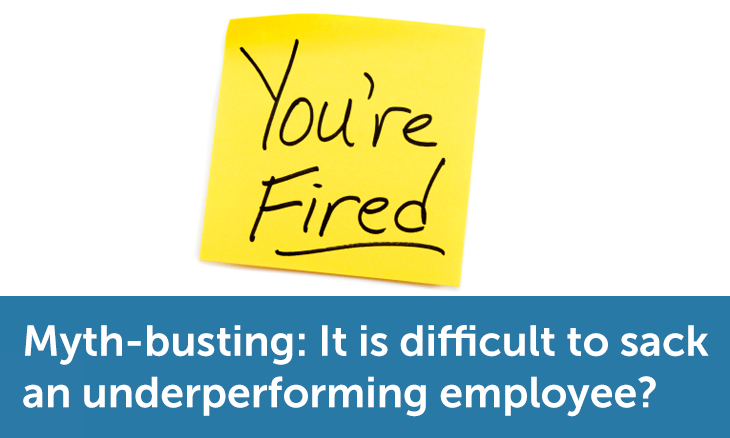 For those with 2 years’ service or more, you can still dismiss quickly and without following any procedure
For those with 2 years’ service or more, you can still dismiss quickly and without following any procedureSo far we have tackled the following myths:
- Employers cannot lawfully dismiss if their employee is genuinely ill
- You can’t make a woman on maternity leave redundant
- Employers must provide exiting staff with a reference
- Employers do not need to do pre-employment immigration checks on British or EU recruits
- In order to dismiss an employee, you must follow procedure
- Parents have the right to work part-time
- It Is Not Possible To Retire Employees Anymore
This time we tackle employee performance.
Myth
It is difficult to sack an underperforming employee.
Busted
Sacking an underperforming employee doesn’t have to be hard work.
If the employee has less than 2 years’ service they can’t normally claim unfair dismissal. So, provided there is no discrimination involved, you can dismiss just by giving them the amount of notice they are entitled to receive under their contract of employment. There is no need to follow a particular procedure, although you may of course wish to do so as a matter of good practice.
Attention Recruiters
See Live Jobs on SplitFee.org – Don’t Miss Out
It’s FREE if you Join Now!
For those with 2 years’ service or more, you can still dismiss quickly and without following any procedure, provided you are willing to make a payment to them. There is nothing to stop you having a ‘protected’ or ‘without prejudice’ conversation to agree an exit, using a settlement agreement to prevent any claims being made. This is likely to be an attractive option if the employee is particularly senior or in a business critical role, or where the manager has lost faith and wants the employee out without going through a formal procedure.
If you do decide to adopt a formal performance management procedure, provided a fair procedure is followed, and the employee is given time to improve, an underperforming employee can be fairly dismissed (unless, of course, performance improves, which happens more than you’d think!)
A formal management process will take time and you may need HR support.
This is what is involved:
- Try and “nip problems in the bud” and deal with performance issues at an early stage. Generally it is best to start with an informal discussion with the employee to find out why their performance has declined. It is helpful to plan in advance what you are going to say so that you can refer to specific examples, set out the improvement expected and consider the timescales for doing so. If the employee needs support or training, this should be provided before their performance is reviewed. Keep a record of your meeting and the steps agreed and give the employee a copy.
- If the employee does not improve, then you can move to a formal process. If you have a performance management or capability policy, follow it. You will need to hold further meetings to set targets, review progress and, if no or only limited improvements are made, to issue warnings. You will not normally be able to dismiss the employee straightaway before giving them the opportunity to improve (unless they have less than 2 years’ service).
- You must tell the employee in advance of any meetings and in writing that they are subject to a formal performance management procedure and warn them of the potential consequences of failing to meet the required standards (such as a formal warning being given, or where previous warnings have been given, dismissal).
- You must always try to establish the reasons for the employee’s underperformance and, where appropriate, take action to support the employee. For example, if the business has introduced new computer systems and the employee is struggling to cope with these provide training to help them to familiarise themselves with the changes (even if everyone else in the team has transitioned smoothly).
- Unless your policy sets out specific time limits, there are no hard and fast rules about the amount of time you should give your employee to improve, provided it is reasonable. Reasonableness will depend upon the reasons why the employee’s performance is unsatisfactory and the stage you have reached in the process. In the example given above, you might initially give the employee 6 weeks after training to improve, but following a further meeting (and warning) reduce this to 4 weeks, and then, after a further meeting (and final warning) perhaps to 2 weeks if no improvement or insufficient progress has been made.
- It is important to make careful notes of all discussions and to set out in writing to the employee the progress required and timescales in writing. That way you can demonstrate that the employee understood what was expected in the event that they complain about their treatment.
- If you are considering dismissal, you must warn the employee in advance of this and hold a further meeting. If you proceed to dismissal, you must advise the employee that they can appeal against their dismissal and if they do so, hear the appeal.
- Dismissal should be on notice. The employee can either be required to work their notice period or can be paid in lieu of notice, depending on what their employment contract says. The reason for their dismissal will be capability, not misconduct.
These steps can take time but, provided you follow them, there is no reason to simply put up with an underperforming employee.
Here’s the COMPLETE set of Accredited Recruitment & HR courses







